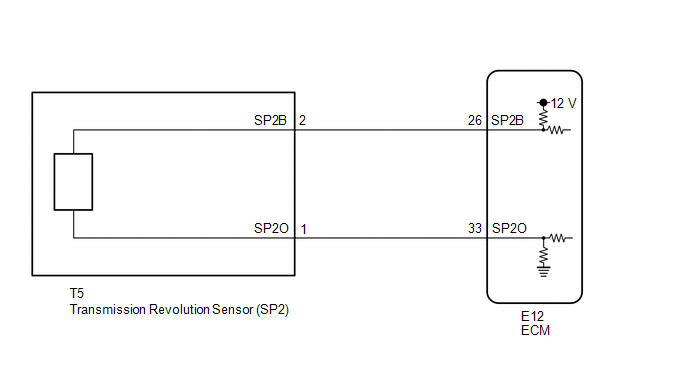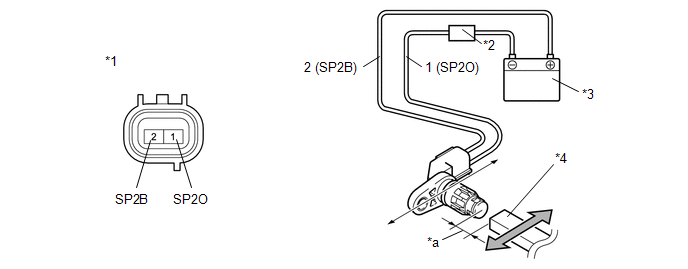Toyota Tacoma (2015-2018) Service Manual: Output Speed Sensor Circuit Short to Battery (P072012,P072014,P072031)
DESCRIPTION
This sensor detects the rotation speed of the transmission output shaft and sends signals to the ECM. By comparing the input turbine speed signal (NT) with the output shaft speed sensor signal (SP2), the ECM detects the shift timing of the gears and appropriately controls the engine torque and hydraulic pressure according to various conditions. As a result, the gears shift smoothly.
|
DTC Code |
DTC Detection Condition |
Trouble Area |
SAE |
|---|---|---|---|
|
P072012 |
When the transmission revolution sensor (SP2) input voltage is higher than 1.8 V for 4.5 seconds or more (1 trip detection logic). |
|
P077D |
|
P072014 |
When the transmission revolution sensor (SP2) input voltage is below 0.2 V for 4.5 seconds or more (1 trip detection logic). |
|
P077C |
|
P072031 |
All conditions are met for 5 seconds or more (1 trip detection logic): (a) Park/neutral position switch D input signal is ON. (b) Either condition is met.
(c) The vehicle speed is 8.99 km/h (5.6 mph) or more. (d) No signal from transmission revolution sensor (SP2) is input to the ECM. |
|
P0722 |
MONITOR DESCRIPTION
The transmission revolution sensor (SP2) detects the transmission output shaft speed. The ECM calculates gear shifts comparing the transmission revolution sensor (NT) with the transmission revolution sensor (SP2).
If the ECM detects no signal from the transmission revolution sensor (SP2) even while the vehicle is moving, it will conclude that there is a malfunction in the transmission revolution sensor (SP2). The ECM will illuminate the MIL and store the DTC.
MONITOR STRATEGY
|
Related DTCs |
P0722: Transmission revolution sensor (SP2)/Verify pulse input P077C: Transmission revolution sensor (SP2)/Range check (Low voltage) P077D: Transmission revolution sensor (SP2)/Range check (High voltage) |
|
Required sensors/Components |
Transmission revolution sensor (NT), Transmission revolution sensor (SP2) |
|
Frequency of operation |
Continuous |
|
Duration |
P0722: 5 sec. P077C, P077D: 4.5 sec. |
|
MIL operation |
Immediate |
|
Sequence of operation |
None |
TYPICAL ENABLING CONDITIONS
All:|
Battery voltage |
8 V or higher |
|
Ignition switch |
ON |
|
Starter |
OFF |
|
Vehicle speed |
8.99 km/h (5.59 mph) or more |
|
Shift change |
Shift change is completed before starting next shift change operation |
|
R position switch |
OFF |
|
D position switch |
ON |
|
Park/neutral position switch (NSW) |
OFF |
|
Engine |
Running |
|
Output speed sensor range check fail (P077C, P077D) (Pending / MIL) |
Not detected |
|
Pressure control solenoid circuit fail (P0748, P0778, P0798, P2716, P2810) (Pending / MIL) |
Not detected |
|
Either of the following conditions is met |
Conditions 1 or 2 |
|
1. All of the following conditions are met |
- |
|
ECM selected gear |
Not 1st |
|
Turbine speed sensor revolution |
760 rpm or more |
|
2. All of the following conditions are met |
- |
|
ECM selected gear |
1st |
|
Turbine speed sensor revolution |
1310 rpm or more |
|
Output speed sensor pulse input fail (P0722) (Pending / MIL) |
Not detected |
TYPICAL MALFUNCTION THRESHOLDS
P0722:|
Output shaft speed sensor signal |
No signal |
|
Intermediate shaft speed sensor voltage |
Below 0.2 V |
|
Intermediate shaft speed sensor voltage |
Higher than 1.8 V |
CONFIRMATION DRIVING PATTERN
CAUTION:
When performing the confirmation driving pattern, obey all speed limits and traffic laws.
HINT:
- After repairs have been completed, clear the DTCs and then check that the vehicle has returned to normal by performing the following All Readiness check procedure.
- When clearing the permanent DTCs, refer to the Clear Permanent DTC procedure
(See page
.gif) ).
).
- Connect the Techstream to the DLC3.
- Turn the ignition switch to ON and turn the Techstream on.
- Clear the DTCs (even if no DTCs are stored, perform the clear DTC procedure).
- Turn the ignition switch off and wait for 2 minutes or more.
- Turn the ignition switch to ON and turn the Techstream on.
- Start the engine.
- Perform the D Position Shift Test inspection in Road Test (See page
.gif) ). [*1]
). [*1]
HINT:
[*1] : Normal judgment procedure.
The normal judgment procedure is used to complete DTC judgment and also used when clearing permanent DTCs.
- Enter the following menus: Powertrain / Transmission / Utility / All Readiness.
- Input the DTC: P072012, P072014 or P072031.
- Check the DTC judgment result.
Techstream Display
Description
NORMAL
- DTC judgment completed
- System normal
ABNORMAL
- DTC judgment completed
- System abnormal
INCOMPLETE
- DTC judgment not completed
- Perform driving pattern after confirming DTC enabling conditions
N/A
- Unable to perform DTC judgment
- Number of DTCs which do not fulfill DTC preconditions has reached ECU memory limit
HINT:
- If the judgment result shows NORMAL, the system is normal.
- If the judgment result shows ABNORMAL, the system has a malfunction.
- If the judgment result shows INCOMPLETE or N/A, perform the normal judgment procedure again.
WIRING DIAGRAM

CAUTION / NOTICE / HINT
NOTICE:
- Perform the universal trip to clear permanent DTCs (See page
.gif) ).
). - Perform registration and/or initialization when parts related to the
automatic transmission are replaced (See page
.gif) ).
).
1. DATA LIST
HINT:
Using the Techstream to read the Data List allows the values or states of switches, sensors, actuators and other items to be read without removing any parts. This non-intrusive inspection can be very useful because intermittent conditions or signals may be discovered before parts or wiring is disturbed. Reading the Data List information early in troubleshooting is one way to save diagnostic time.
NOTICE:
In the table below, the values listed under "Normal Condition" are reference values. Do not depend solely on these reference values when deciding whether a part is faulty or not.
(a) Warm up the engine.
(b) Turn the ignition switch off.
(c) Connect the Techstream to the DLC3.
(d) Turn the ignition switch to ON.
(e) Turn the Techstream on.
(f) Enter the following menus: Powertrain / Transmission / Data List.
(g) According to the display on the Techstream, read the Data List.
Transmission|
Tester Display |
Measurement Item/Range |
Normal Condition |
Diagnostic Note |
|---|---|---|---|
|
Speed (SP2) |
Output shaft speed/ Min.: 0 km/h (0 mph) Max.: 255 km/h (158 mph) |
0 km/h (0 mph): Vehicle stopped (equal to vehicle speed) |
- |
HINT:
- Speed (SP2) is always 0 while driving: Open or short in the sensor or circuit.
- Speed (SP2) value displayed on the Techstream is much lower than the actual vehicle speed: Sensor trouble, improper installation, or intermittent connection trouble of the circuit.
PROCEDURE
|
1. |
READ VALUE USING TECHSTREAM (SPEED (SP2) AND SP2 SENSOR VOLTAGE) |
(a) Connect the Techstream to the DLC3.
(b) Turn the ignition switch to ON.
(c) Turn the Techstream on.
(d) Enter the following menus: Powertrain / Transmission / Data List
(e) In accordance with the display on the Techstream, read the Data List.
Transmission|
Tester Display |
Measurement Item/Range |
Normal Condition |
Diagnostic Note |
|---|---|---|---|
|
Speed (SP2) |
Output shaft speed/ Min.: 0 km/h (0 mph) Max.: 255 km/h (158 mph) |
0 km/h (0 mph): Vehicle stopped (equal to vehicle speed) |
- |
|
SP2 Sensor Voltage |
Transmission revolution sensor (SP2) output voltage/ Min.: 0.000 V Max.: 4.999 V |
0.1 to 1.9 V: Engine idling |
- |
|
Result |
Proceed to |
|---|---|
|
Data display is not within Normal Condition range |
A |
|
Data display is within Normal Condition range |
B |
| B | .gif) |
REPLACE ECM |
|
|
2. |
INSPECT TRANSMISSION REVOLUTION SENSOR (SP2) |
(a) Remove the transmission revolution sensor (SP2) (See page
.gif) ).
).
(b) Connect the battery to the sensor as shown in the illustration.
 Text in Illustration
Text in Illustration
|
*1 |
Transmission Revolution Sensor (SP2) |
*2 |
Ammeter |
|
*3 |
Battery |
*4 |
Magnet |
|
*a |
5 mm (0.197 in.) or less |
- |
- |
(c) Wave a magnetic object left and right in front of the transmission revolution sensor (SP2) tip (5 mm (0.197 in.) or less) to change the high/low signals while measuring the current.
NOTICE:
Make sure to wave the magnetic object during the inspection. The current will not change without waving the magnetic object as indicated by the arrow in the illustration.
(d) Measure the current according to the value(s) in the table below.
Standard Current:
|
Tester Connection |
Condition |
Specified Condition |
|---|---|---|
|
1 (SP2O) - 2 (SP2B) |
Low signal |
4 to 8 mA |
|
1 (SP2O) - 2 (SP2B) |
High signal |
12 to 16 mA |
| NG | .gif) |
REPLACE TRANSMISSION REVOLUTION SENSOR (SP2) |
|
|
3. |
CHECK HARNESS AND CONNECTOR (TRANSMISSION REVOLUTION SENSOR (SP2) - ECM) |
(a) Disconnect the T5 transmission revolution sensor (SP2) connector.
(b) Disconnect the E12 ECM connector.
(c) Measure the resistance according to the value(s) in the table below.
Standard Resistance:
|
Tester Connection |
Condition |
Specified Condition |
|---|---|---|
|
T5-2 (SP2B) - E12-26 (SP2B) |
Always |
Below 1 Ω |
|
T5-1 (SP2O) - E12-33 (SP2O) |
Always |
Below 1 Ω |
|
T5-2 (SP2B) - Body ground |
Always |
10 kΩ or higher |
|
T5-1 (SP2O) - Body ground |
Always |
10 kΩ or higher |
| OK | .gif) |
REPLACE ECM |
| NG | .gif) |
REPAIR OR REPLACE HARNESS OR CONNECTOR |
 Input/Turbine Speed Sensor "A" Circuit Short to Battery (P071512,P071514,P071531)
Input/Turbine Speed Sensor "A" Circuit Short to Battery (P071512,P071514,P071531)
DESCRIPTION
This sensor detects the rotation speed of the turbine which shows the input turbine
speed of the transmission. By comparing the input turbine speed signal (NT) with
the output shaft s ...
 Pressure Control Solenoid "A" Circuit Open (P074513)
Pressure Control Solenoid "A" Circuit Open (P074513)
DESCRIPTION
Changing from 1st to 6th is performed by the ECM turning shift solenoid valves
SL1, SL2, SL3 and SL4 on and off. If an open or short circuit occurs in any of the
shift solenoid valves ...
Other materials:
Vehicle Speed Signal Malfunction (B2282,B2283)
DESCRIPTION
DTC B2282 is stored when the vehicle speed signal sent by the combination meter
assembly via direct line and the vehicle speed signal sent via CAN communication
do not match.
DTC B2283 is stored when a malfunction in the vehicle speed sensor is detected.
HINT:
When the cable is d ...
Precaution
PRECAUTION
IGNITION SWITCH EXPRESSIONS
(a) The type of ignition switch used on this model differs according to the specifications
of the vehicle. The expressions listed in the table below are used in this section.
Expression
Ignition Switch (Position)
Engine Swi ...
Cruise Control Input Processor (P160700)
DESCRIPTION
The ECM continuously monitors its main and sub CPUs. This self-check ensures
that the ECM is functioning properly. If outputs from the CPUs are different and
deviate from the standard, the ECM will illuminate the MIL and store the DTC.
DTC No.
Detection Item
...

.gif)